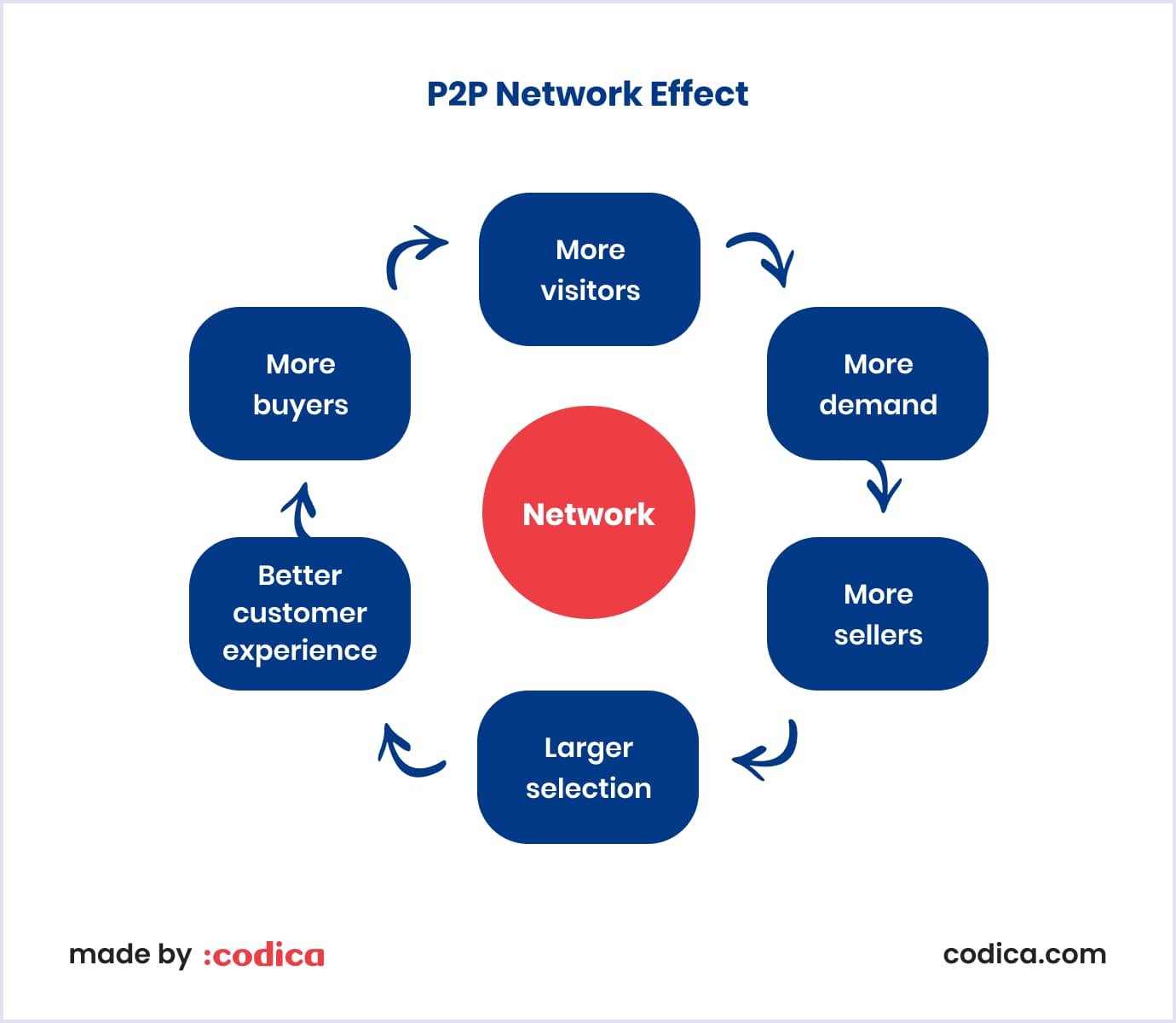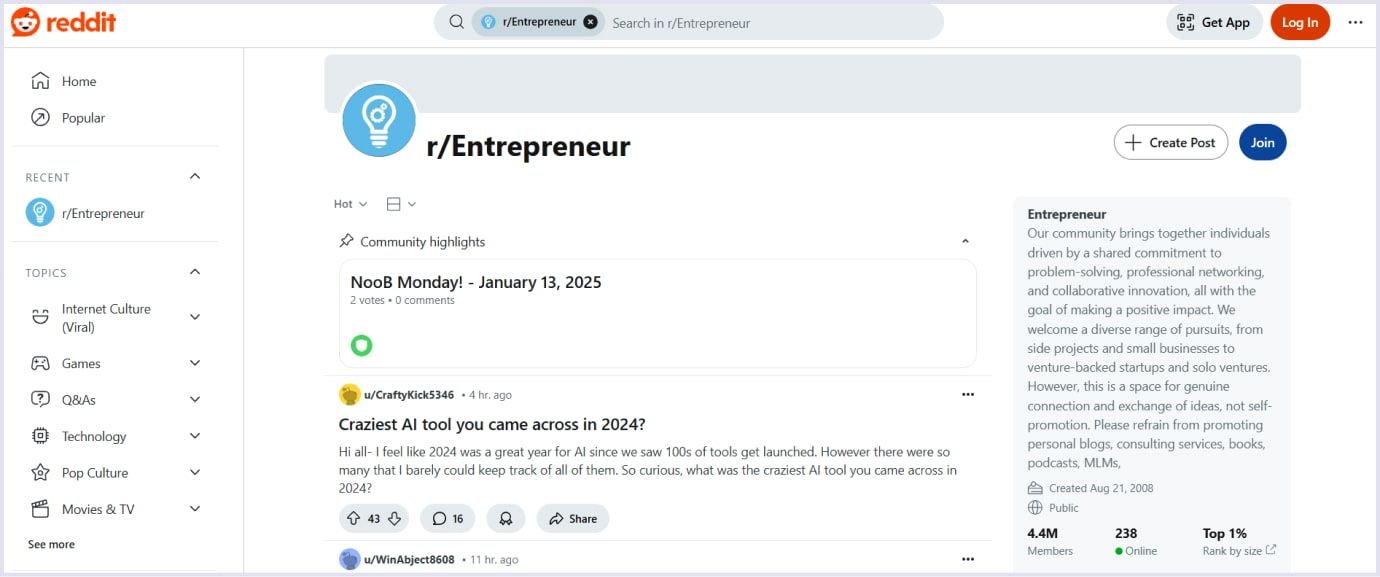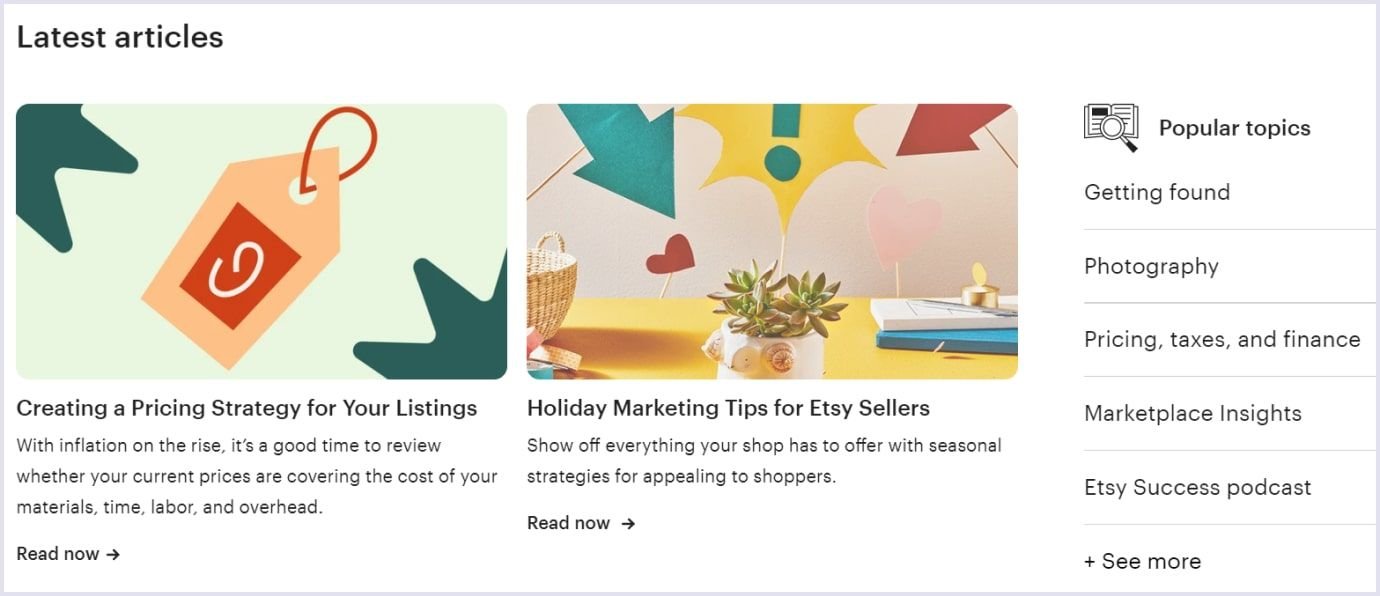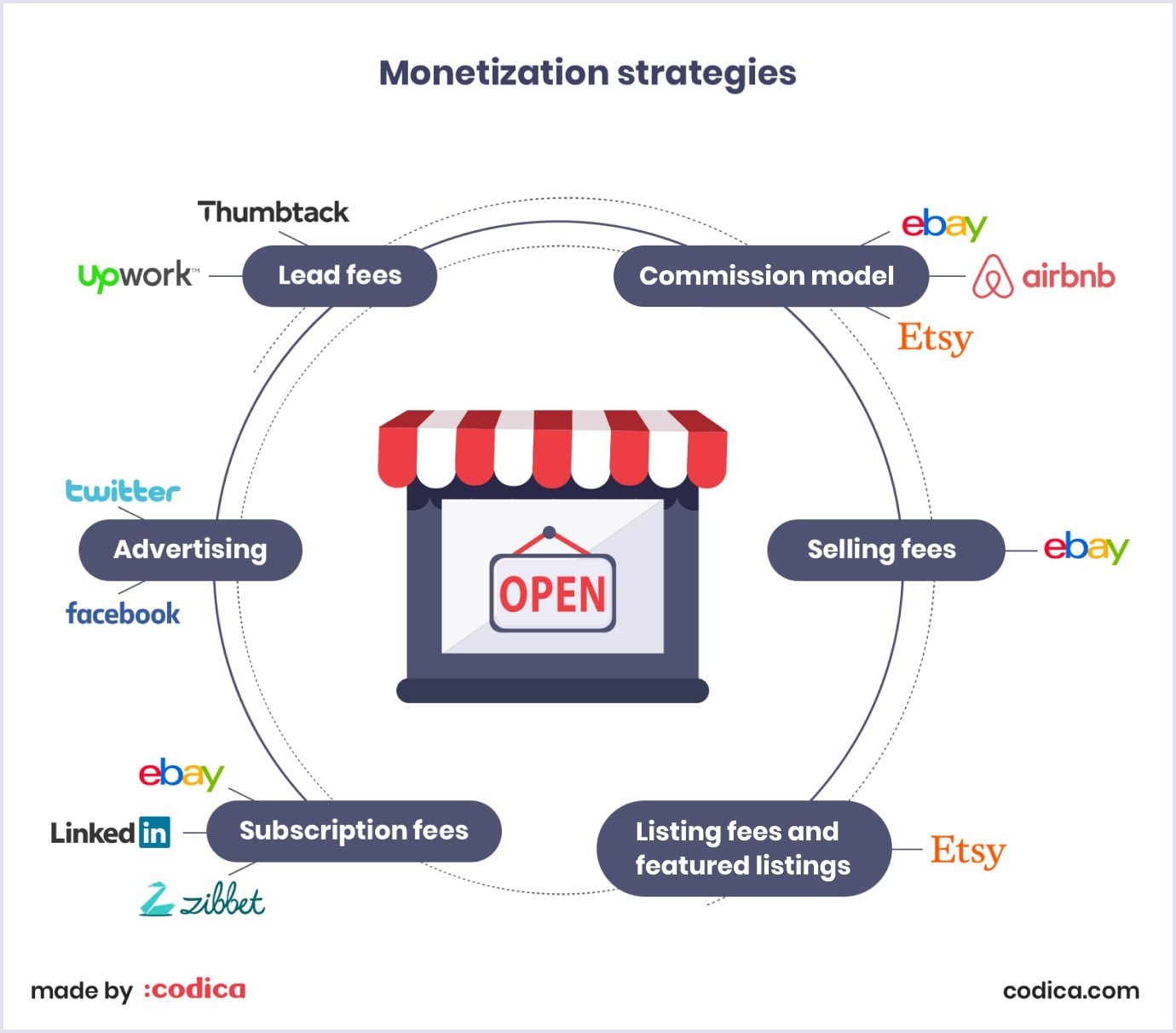If you're looking to make your marketplace a success, then you've got to focus on user acquisition. By getting buyers and sellers on board, you're helping to boost revenue and make your mark in the ecommerce industry.
We've put together this list of 14 awesome strategies to get both vendors and shoppers excited about your P2P marketplace. Check out this guide to grow your marketplace and take your ecommerce business to the next level.
What are P2P marketplaces?
Let's start with the very basics. A P2P marketplace is short for peer-to-peer marketplace, meaning a place where buyers and sellers interact directly. Users can switch roles so easily on these platforms, and that is really what makes them so special.
For example, a user can rent his apartment in London on Airbnb while at the same time booking a beachfront room elsewhere. This is why P2P platforms are often called two-sided marketplaces.
Like any marketplace, P2P platforms face the “chicken-and-egg” problem - the challenge of attracting buyers and sellers simultaneously. To overcome this, you’ll need a well-thought-out strategy that brings value to both sides and ensures active engagement on your platform.

In this article, we will consider effective ways of user acquisition. User acquisition (UA) means the process when you attract sellers and buyers to the online platform. The main purpose of UA is to build and improve an application, platform, or company’s brand awareness and attract customers.
Below we discuss the most effective and quick ways to attract buyers and sellers to P2P marketplaces.
How to attract sellers to your marketplace?
The following seven practices will help you to engage more sellers and grow your business.
1. Provide sellers with the number of buyers on-board
Sellers will never join a marketplace unless they have some confidence that their products will attract buyers. To activate sellers, your platform must be able to show them that it can generate demand for their goods or services; this could be done by demonstrating the platform's potential to connect them with relevant, interested customers.
First, you need to incentivise sellers to list their products or services, even before the marketplace has a large buyer base. You can offer promotions, discounts or reduced commission fees to early adopters. Once you have an initial supply of products or services, you will be able to attract buyers, creating a virtuous circle of growth.
In this way, by showing them the value of your marketplace and how it can drive sales, you will give sellers the confidence to invest their time and resources. Perhaps a message like this could work: "Join a growing platform designed to connect you with customers looking for exactly what you offer." Make the benefits clear and guarantee future demand to gain their trust.
2. Contact active sellers from other platforms
One of the easiest and fastest ways of acquiring vendors for your marketplace is using existing online and offline platforms.
You can visit business-related conferences and events that connect entrepreneurs. They are advertising their goods to find new customers at such events. So, it is a perfect opportunity to communicate with them and engage vendors on your platform.
In terms of online platforms, sellers may use:
- Forums (Web Retailer, Amazon Seller Central, Ecommerce Fuel Forum),
- Q&A platforms (Quora, Reddit, Voat, ProductHunt),
- Other marketplace platforms (Amazon, eBay, Flipkart).
As of 2025, Reddit offers various subreddits for entrepreneurs, with r/Entrepreneur being one of the most popular, boasting 4.5 million members.

Source: Reddit
Once you've picked the right platform, you should contact active sellers from other platforms. Your web solution should make it easy for them to join. Show them the perks of your platform compared to other market options.
3. Implement useful guides on your peer-to-peer marketplace
The ecommerce market includes both experienced and entry-level sellers. The latter do not know all the tips and tricks that can help them sell their items.
You can attract vendors by making your marketplace platform easy to use. For instance, you can add guidelines or blog posts. This will increase your chances of becoming the sellers’ choice as you give them some value.
Also, you can build a separate platform section with useful guides for each product category. This method was implemented by Etsy and allowed them to engage sellers effectively. The platform’s part advises how to run an online business in multiple categories successfully.

Source: Etsy
4. Research vendors’ expectations and provide an exclusive offer
Vendors, as any users, appreciate when you take care of them and make allowance for their needs and desires. So, one more effective user acquisition tactic to engage sellers is to provide them with an exclusive offer in your marketplace software.
Let’s take a look at the most common expectations of vendors:
- A possibility to enter new markets and find new customers;
- An ability to use marketplace platform advanced features for better advertising;
- The chance to estimate their business activity.
To conclude, always research sellers’ expectations to provide value to them. For instance, offer vendors useful analytics tools that allow them to improve sales. This method greatly stimulates sellers to join peer-to-peer marketplaces and actively operate on them.
It is also essential to conduct surveys regularly and collect focus groups of the largest sellers. By communicating with them, you will better understand what they lack in your solution.

5. Implement suitable and clear commission models
When you launch a peer-to-peer marketplace and get sellers, they want to know exactly what they will pay for. It greatly affects their trust level and the final decision of whether to start selling on your platform or not.
Let’s briefly cover some of the most efficient and suitable monetization strategies for fruitful seller acquisition.
- Commission model. You charge a set amount for each transaction made on the platform.
- Listing fees. Sellers pay a fixed amount when they list their items for sale.
- Featured listings. These listings place sellers' ads at the top of search results. This makes them easy for customers to see.
- Advertising. In this model, third-party companies pay to place their ads on your P2P marketplace.
- Seller fees. Sellers pay a portion of each payment before it reaches them.
- Subscription fees. A monthly or annual payment to gain access to the platform.

6. Offer inventory management tools
Another great way to attract and retain sellers is to provide them with inventory management tools. By simplifying the process of tracking and managing their inventory, you improve the seller experience and build long-term trust in your platform. You give people a reason to sell on your marketplace by providing tools that help organize inventory and keep operations running smoothly.
For example, give sellers the ability to specify available quantities of an item and create low stock notifications. That way, they can replenish products in time to keep their business running smoothly. Built-in inventory management on platforms like BigCommerce allows sellers to update inventory levels, track orders, and even offer multichannel selling by integrating with third-party tools.
7. Create a solid seller support system
Customer support is an important aspect of lucrative P2P marketplaces that will help you attract vendors. It allows your users to get support for any issue that may emerge on the platform. So, it makes both buyers and sellers feel that the ecommerce marketplace platform takes care of them.
This fact improves platform-user relationships and creates a smooth shopping/selling experience.
Keep in mind that comprehensive support for sellers ensures long-lasting value for your platform. So, finding answers and getting support is essential for sellers. Otherwise, they may just leave your platform and proceed to competitors.
What are the problems sellers may face using a marketplace platform for sales? These are some of the most popular:
- The review isn't about the product itself. Sometimes buyers leave bad reviews just to stir things up. So, the vendor should be able to dispute the negative comment.
- There have been some issues with warehouses. For example, a consignment of goods might go missing, or liquid assets might return, even though everything was fine when they were shipped. Sellers should be able to make a formal request and receive compensation.
- And delivery needs to be adjusted. Sometimes the documents get filled out wrong, and the seller catches it. This issue needs to be resolved without penalties or sanctions for breaking the rules.
For instance, Amazon Seller Central, a comprehensive platform for sellers, enables them to choose the relevant issue topic when needed and report about a certain problem. This way, Amazon attracts sellers and builds a strong relationship with them.
How to attract buyers to your marketplace?
There are a bunch of ways to get buyers to marketplaces, and we've got the most effective ones right here.
1. Create a pre-launch landing page and offer credits
A pre-launch landing page is a powerful way to build excitement and attract buyers before your marketplace goes live. Think of it as a sneak peek that gets people curious and engaged. Use the page to share updates about your upcoming launch and highlight why your platform is worth their attention.
To encourage early sign-ups, offer something irresistible - like $100 in free credits for registering before launch. This not only gets people excited but also gives them a reason to return and explore your marketplace once it’s live.
Offering free credits is a smart move to turn early interest into real engagement. For example, if your products or services cost slightly more than the credit amount, buyers are likely to spend a bit of their own money to make a purchase.
Plus, using a seller commission model can help offset costs, making this strategy even more effective. When your platform launches, remind those early subscribers about their credits with a friendly nudge: “Your $100 credit is ready - start shopping today!” It’s a simple way to create excitement and ensure your marketplace starts off strong.
2. Build a referral system
Develop a referral system pre-launch that will definitely increase user acquisition and engagement for your marketplace. Allow buyers to invite their friends via social media or email in exchange for free credits, such as:
- Invite 10 additional friends, and you'll earn $20 in free credits.
- Invite 20 additional friends, and you'll unlock more than $40 in free credits.
- Invite 50 additional friends, and you'll receive over $150 in free credits.
This can go viral and attract more buyers to your platform. One of the best examples of this is Airbnb's referral program, which incentivizes users with travel credits. Their messaging "Give your friends $25 to travel" performed better than "Invite your friends, receive $25" since it focuses on value for the referred user.
A well-designed referral system can create buzz and grow your user base even before your platform launches.
3. Offer free products for early registration
While pre-launch landing pages and free credits are great, free products take user acquisition to a whole other level. This approach is a win-win for everyone involved, helping you get users on board for your P2P marketplace even before it goes live.
How does it work? Partner with suppliers who would provide a select few of their products for free. Everybody wins this way:
- Vendors: they are getting free promotion and visibility to a new set of audiences, possibly for long-term business relationships with your platform.
- Buyers: they would have an incentive to sign up at your marketplace since they get free products without any hidden agendas.
- Marketplace owners: you bring in a huge amount of users in the beginning, integrate with suppliers, and generate buzz about your marketplace.
One really good example of this is the early-access campaign pulled off by Creative Market. By giving away products for free during their pre-launch phase, they were able to bring eyes to their marketplace and develop a loyal user base before launching.
“Since announcing our plans for Creative Market several weeks ago, we’ve had an amazing response from creative folks around the world. Nearly 40k people signed up for our early access list, and thousands have filled out our buyer & seller surveys, helping us fine-tune the best marketplace experience we can build.” Darius Monsef
This methodology drives not only user acquisition but also serves to position your marketplace as a place with real value, hence it can be highly effective even before launch.
4. Set different constraints
Another good way to get buyers interested is to make your platform feel like it's got limited inventory. You can do this by limiting the quantity or time available for access. This makes consumers want to buy as soon as they can.
People also like the idea of owning something that others can't get. This creates a lot of excitement among users. It also gets a lot of people to join your platform to get a certain product.
Let's dive into the different types of constraints.
Quantity constraint
It's one of the most popular models for ecommerce. It means you show a small selection of products and let people know how many are left. It gets buyers interested and makes them want to buy that item.
Booking.com is a great example of this strategy.

Source: Booking.com
Time constraint
This model means you set a limited time for a given offer. It usually works really well with discounts, so buyers have two good reasons to make a purchase.
Amazon is a great example of using both time limits and discounts.

Source: Amazon
You may also like: How to Build a Multi-Vendor Marketplace Website Like Amazon
5. Find and solve user problems
This point may seem obvious, but it is definitely vital for successful user acquisition. Problems of each potential buyer may range depending on many factors such as demographics, age, interests, and so on. By conducting the product discovery session at Codica, we help our clients define their target audience's needs.
For instance, recently, our team developed a custom ecommerce solution. This project is the first such a large P2P multi-vendor marketplace in the UK and Europe. With multi-vendor marketplace development services, the founder solved the problems of many users who want to buy and sell within one platform. This platform includes both B2C and C2C segments within one solution.
Thus, users can offer and buy goods and services within one marketplace by switching between the platform’s parts. Also, users have the ability to share their customer experience with each other. This function enhances customer loyalty and builds trust in your brand.
This handy marketplace is easy to use and offers a great experience. Customers can even search for services or products and choose a certain location. This makes it a great solution for buyers.
Below you can watch a short video about this multi-functional and robust ecommerce solution.
6. Use social media
A great number of users are registered on social networks. Each of them is a potential buyer. Research tells us that 74% of people trust social media to guide their shopping decisions. So, analyze your target audience. Can these people use social media? If the answer is yes, then your company should be in this digital space too.
Nowadays, the fastest-growing social media networks include Facebook, Instagram, TikTok, and YouTube. You can use them, for instance. There, you can publish ads and tell your subscribers about sales, contests, and so on.
eBay also actively uses social media to promote its platform and engage new customers. This giant has its accounts on Facebook, Instagram, and Twitter.

Source: Instagram
So, don't hesitate and dive into the social media world!
7. Develop an effective email marketing
Indeed, social media is a great channel for engaging the audience. But email letters are also effective for attracting customers.
If you want to get the most out of your mailings, you've got to organize them right. We've got some great tips for you below:
- Use newsletters to inform the target audience about new discounts or promotions;
- Notify subscribers about new services or products, as well as cost reductions on them;
- Carry out the surveys via mailing lists;
- Use referral rewards such as bonuses for inviting friends;
- Send out emails with reviews of interesting products;
- Conduct contests and other engaging events.
Want to stay ahead in your email marketing game? Create better customer relationships with smart email campaigns.
By the way, sign up to Codica’s newsletter to get expert tips, industry insights, and exclusive strategies that will help your business grow.
Now, let’s pass on the working ways of attracting sellers to your web solution.
Use the above strategies and grow
Acquiring users is a key part of launching a profitable P2P website. Along with making your platform functional, you need to attract buyers and sellers to start making a profit and boost the market presence of your peer-to-peer marketplace software. We hope this detailed guide helps you get sellers and buyers on your peer-to-peer marketplace platform. There are definitely other strategies out there, but we've shared the most effective user acquisition methods.
If you're looking for a reliable online marketplace development company, our team is here to help you build a P2P website. Contact us to discuss your project and bring your business idea into reality.

